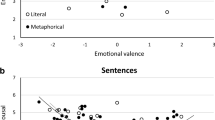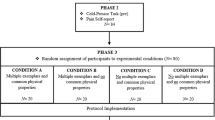Abstract
Metaphors are used in everyday language and play a role in the therapeutic domain. This paper: 1) Examines the linguistic structure of metaphors for its therapeutic relevance. 2) Introduces the concept and use of metaphoric kernel statements. 3) Describes strategic and tactical applications of metaphor in guided metaphoric imagery work, storytelling and metaphoric tasks. 4) Demonstrates the efficacy of metaphor in treatment of cases of traumatic and highly anxiety-provoking issues.
Similar content being viewed by others
References
Aleksandrowicz, D.R. (1962). The meaning of metaphor.Bulletin of the Menninger Clinic, 26, 92–101.
Andolfi, N., Mengiti, P., Nicolo-Corioliano, A.N. & Angelo, C. (1983).Behind the family mask. New York: Brunner/Mazel.
Barker, P. (1985).Using metaphors in psychotherapy. New York: Brunner/Mazel.
Black, M. (1962).Models and metaphors: Studies in language and philosophy. Ithaca, NY: Cornell University Press.
Brink, N.E. (1982). Metaphor creation for use within family therapy.American Journal of Clinical Hypnosis, 24, 258–265.
Brown, D.P. & Fromm, E. (1986),Hypnotherapy and hypnoanalysis. Hillsdale, NJ: L. Erlbaum Associates.
Brunner, J. (1957). Going beyond the information given. In: H.E. Gruter et al. (Eds.),Contemporary approaches to language. Cambridge: Cambridge University Press.
Caruth, E. & Ekstein, R. (1966). Interpretation within metaphor: Further considerations.American Academy of Child Psychiatry Journal, 5, 35–45.
Ekstein, R. & Wallerstein, J. (1956). Observations on the psychotherapy of borderline and psychotic children.The Psychoanalytic Study of the Child, 11, 303–311.
Ekstein, R. & Wright, D. (1952). The space child.Bulletin of the Menninger Clinic, 16, 211–224.
Erickson, M.H. (1935). A study of an experimental neurosis hypnotically induced in a case of ejaculatio praecox.British Journal of Medical Psychology, 15, 34–50. Also in: J. Haley (Ed.),Advanced techniques of hypnosis and therapy. New York: Grune & Stratton, 1967.
Erickson, M.H. (1944). The method employed to formulate a complex story for the induction of the experimental neurosis.Journal of Genetic Psychology, 31, 67–84. Also in: J. Haley (Ed.),Advanced techniques of hypnosis and therapy. New York: Grune & Stratton.
Fernandez, J.V. (1977). The performance of ritual metaphors. In: J.D. Sapir & J.C. Crocker (Eds.),The social use of metaphors: Essays on the anthropology of the rhetoric. Philadelphia: University of Pennsylvania Press.
Friedman, B. (1988). Personal communication.
Gindhart, L.R. (1981). The use of a metaphoric story in therapy: A case report.American Journal of Clinical Hypnosis, 23, 202–206.
Gordon, D. (1978).Therapeutic metaphors. Cupertino, CA: Meta Publications.
Greenleaf, E. (1978). Active imagining. In: J.L. Singer & K.S. Pope (Eds.),The power of human imagination. New York: Plenum Press.
Haynes, R. (1975). Metaphor as interactive.Educational Theory, 25, 272–277.
Kopp, S.B. (1971).Guru: Metaphors from a psychotherapist. Palo Alto, CA: Science & Behavior Books.
Kopp, S.B. (1972).If you meet the Buddha on the road, kill him! Palo Alto, CA: Science & Behavior Books.
Kroger, V.S. & V.D. Fezler (1976).Hypnosis and behavior modification. Philadelphia: J.B. Lippincott.
Lankton, S.R. & Lankton, C.H. (1983).The answer within: A clinical framework of Ericksonian hypnotherapy. New York: Brunner/Mazel.
Lankton, S.R. & Lankton, C.H. (1986).Enchantment and intervention in family therapy: Training in Ericksonian approaches. New York: Brunner/Mazel.
Leuner, H. (1978). Basic principles and therapeutic efficacy of guided affective imagery. In: J.L. Singer & K.S. Pope (Eds.),The power of human imagination. New York: Plenum Press.
Miller, G., Galanter, E. & Pribram, K. (1960).Plans and the structure of behavior. New York: Holt.
Mills, J.C. & Crowley, R.J. (1986).Therapeutic metaphors for children and the child within. New York: Brunner/Mazel.
Muncie, V. (1937). The psychopathology of metaphor.Archives of Neurology and Psychiatry, 37, 796–804.
Orthony, A., Reynolds, R.E. & Arter, J.A. (1978). Metaphor: Theoretical and empirical research.Psychological Bulletin, 85, 919–943.
Papp, P. (1982). Staging reciprocal metaphors in a couples group.Family Process, 21, 453–467.
Perrine, L. (1971). Four forms of metaphor.College English, 33, 125–138.
Peseschkian, N. (1982).The merchant and the parrot: Oriental stories as tools in psychotherapy. New York: Vantage Press.
Reider, N. (1972). Metaphor as interpretation.International Journal of Psycho-Analysis, 53, 463–469.
Richards, I.A. (1936).The philosophy of rhetoric. London: Oxford University Press.
Rothenberg, A. (1979). Homospatial thinking in creativity.Archives of General Psychiatry, 33, 17–26.
Rothenberg, A. (1984). Creativity and psychotherapy.Psychoanalysis and Contemporary Thought, 7, 233–268.
Sargent, G.A. (1988). A burial at sea. In: O. Van der Hart (Ed.),Coping with loss: The therapeutic use of leave-taking rituals. New York: Irvington Publishers.
Sapir, F. (1934). Symbolism.Encyclopaedia of the Social Sciences, 14, 492–493. Also in: D.G. Mandelbaum (Ed.) (1949),Selected writings of Edward Sapir in language, culture & personality Berkeley: University of California Press.
Seltzer, V. & M. Seltzer (1983). Material, myth and magic: A cultural approach to family therapy.Family Process, 22, 3–14.
Sharpe, E.F. (1940). Psycho-physical problems revealed in language: An examination of metaphor.International Journal of Psycho-Analysis, 21, 201–213. Also in: E.F. Sharpe,Collected papers on psycho-analysis. London: Hogarth, 1950.
Sledge, W.H. (1977). The therapist's use of metaphor.International Journal of Psycho-Analysis, 6, 113–130.
Turner, V.W. (1967).The forest of symbols. Ithaca, NY: Cornell University Press.
Van der Hart, O. (1983).Rituals in psychotherapy. New York: Irvington.
Van der Hart, O. (1985). Metaphoric hypnotic imagery in the treatment of functional amenorrhea.American Journal of Clinical Hypnosis, 27, 159–165.
Van der Hart, O. (1985). Metaphoric and symbolic imagery in the hypnotic treatment of an urge to wander: A case report.Australian Journal of Clinical and Experimental Hypnosis, 13, 83–95.
Van der Hart, O. (Ed.) (1988).Coping with loss: The therapeutic use of leave-taking rituals. New York: Irvington.
Van der Hart, O. & S. Boon (1988). Schrijfopdrachten en hypnose voor de verwerking van traumatische herinneringen.Dth: Directieve Therapie, 8(1), 4–44.
Walch, S.I. (1978). The red balloon technique of hypnotherapy: A clinical note.International Journal of Clinical and Experimental Hypnosis, 24, 10–12.
Welch, M.J. (1984). Using metaphor in psychotherapy.Journal of Psychosocial Nursing, 22, 13–18.
Wheelwright, P.E. (1962).Metaphor and reality. Bloomington: Indiana University Press.
Wheelwright, P.E. (1968).The burning fountain. Bloomington: Indiana University Press.
Witztum, E., Dasberg, H. & Bleich, A. (1986). Use of a metaphor in the treatment of combat-induced Posttraumatic Stress Disorder.American Journal of Psychotherapy, 40, 457–465.
Zeig, J. (1980), Erickson's use of anecdotes. In: J. Zeig (Ed.),A teaching seminar with Milton H. Erickson, M.D. New York: Brunner/Mazel.
Author information
Authors and Affiliations
Rights and permissions
About this article
Cite this article
Witztum, E., van der Hart, O. & Friedman, B. The use of metaphors in psychotherapy. J Contemp Psychother 18, 270–290 (1988). https://doi.org/10.1007/BF00946010
Issue Date:
DOI: https://doi.org/10.1007/BF00946010




